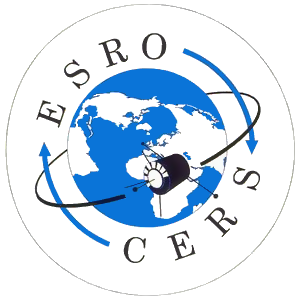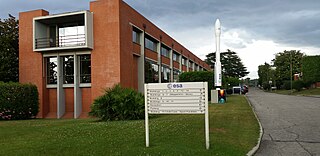
The European Space Operations Centre (ESOC) serves as the main mission control centre for the European Space Agency (ESA) and is located in Darmstadt, Germany. ESOC's primary function is the operation of uncrewed spacecraft on behalf of ESA and the launch and early orbit phases (LEOP) of ESA and third-party missions. The Centre is also responsible for a range of operations-related activities within ESA and in cooperation with ESA's industry and international partners, including ground systems engineering, software development, flight dynamics and navigation, development of mission control tools and techniques and space debris studies.

The European Space Agency is an intergovernmental organisation of 22 member states dedicated to the exploration of space. Established in 1975 and headquartered in Paris, ESA has a worldwide staff of about 2,200, as of 2018, and an annual budget of about €4.9 billion, as of 2023.

Leonardo S.p.A., formerly Leonardo-Finmeccanica and originally Finmeccanica, is an Italian multinational company specialising in aerospace, defence and security. Headquartered in Rome, Italy, the company has 180 sites worldwide. It is the eighth largest defence contractor in the world based on 2018 revenues. The company is partially owned by the Italian government, which holds 30.2% of the company's shares and is its largest shareholder.

The European Organisation for the Exploitation of Meteorological Satellites (EUMETSAT) is an intergovernmental organisation created through an international convention agreed by a current total of 30 European Member States.

The European Space Astronomy Centre (ESAC) near Madrid in Spain is the ESA's centre for space science. It hosts the science operation centres for all ESA astronomy and planetary missions together with their scientific archives. Past and present missions represented at ESAC include Akari, BepiColombo, Cassini–Huygens, Cluster, Exomars, Gaia, Herschel, Hubble, ISO, INTEGRAL, IUE, LISA Pathfinder, Mars Express, Planck, Rosetta, SOHO, Solar Orbiter, Venus Express, and XMM-Newton.

The European Space Research Organisation (ESRO) was an international organisation founded by 10 European nations with the intention of jointly pursuing scientific research in space. It was founded in 1964. As an organisation ESRO was based on a previously existing international scientific institution, CERN. The ESRO convention, the organisations founding document outlines it as an entity exclusively devoted to scientific pursuits. This was the case for most of its lifetime but in the final years before the formation of ESA, the European Space Agency, ESRO began a programme in the field of telecommunications. Consequently, ESA is not a mainly pure science focused entity but concentrates on telecommunications, earth observation and other application motivated activities. ESRO was merged with ELDO in 1975 to form the European Space Agency.

The European Space Research and Technology Centre (ESTEC) is the European Space Agency's main technology development and test centre for spacecraft and space technology. It is situated in Noordwijk, South Holland, in the western Netherlands, although several kilometers off the village but immediately linked to the most Northern district of the nearby town Katwijk.
The European Space Tracking (ESTRACK) network consists of a number of ground-based space-tracking stations belonging to the European Space Agency (ESA), and operated by the European Space Operations Centre (ESOC) in Darmstadt, Germany. The stations support various ESA spacecraft and facilitate communications between ground operators and scientific probes such as XMM-Newton, Mars Express, BepiColombo, Gaia. Similar networks are run by the USA, China, Russia, Japan, and India.
Telespazio Spa is a European spaceflight services company founded in 1961. It is a joint venture owned by Leonardo (67%) and Thales Group (33%) headquartered in Rome.
The Satellite Control and Operation System 2000 (SCOS-2000) is the generic satellite Mission Control System (MCS) software infrastructure developed and maintained by the European Space Agency (ESA/ESOC) in collaboration with European industry and deployed for missions such as Radarsat 2, XMM-Newton, INTEGRAL, Cryosat, Mars Express, Venus Express, GOCE, Herschel, Planck, Rosetta, Cryosat-2, Galileo, MetOp, LISA Pathfinder, SWARM, Gaia, SENTINEL spacecraft or EXOMARS orbiters. Upcoming missions that will deploy SCOS-2000 include MetOp-SG, METEOSAT Third Generation, Aeolus, EarthCARE, BepiColombo, SOLO or EUCLID.

The European Astronaut Centre (EAC), is an establishment of the European Space Agency and home of the European Astronaut Corps. It is near to Cologne, Germany, and is subdivided into six separate arms, these being Astronaut Training, Space Medicine, Astronaut Management, Human Exploration of the Moon as part of the Spaceship EAC initiative and Communications. It provides training facilities for European and international partner astronauts, particularly regarding ESA hardware for the ISS such as Columbus and formerly the ATV. The overall European Astronaut Centre organisation is also in charge of the organisation of the training of European astronauts in the centers of other partners, such as the United States, Russia, Canada (Saint-Hubert) or Japan (Tsukuba).

Copernicus is the Earth observation component of the European Union Space Programme, managed by the European Commission and implemented in partnership with the EU Member States, the European Space Agency (ESA), the European Organisation for the Exploitation of Meteorological Satellites (EUMETSAT), the European Centre for Medium-Range Weather Forecasts (ECMWF), the Joint Research Centre (JRC), the European Environment Agency (EEA), the European Maritime Safety Agency (EMSA), Frontex, SatCen and Mercator Océan.

Metop is a series of three polar-orbiting meteorological satellites developed by the European Space Agency (ESA) and operated by the European Organisation for the Exploitation of Meteorological Satellites (EUMETSAT). The satellites form the space segment component of the overall EUMETSAT Polar System (EPS), which in turn is the European half of the EUMETSAT / NOAA Initial Joint Polar System (IJPS). The satellites carry a payload comprising 11 scientific instruments and two which support Cospas-Sarsat Search and Rescue services. In order to provide data continuity between Metop and NOAA Polar Operational Environmental Satellites (POES), several instruments are carried on both fleets of satellites.

Thales Alenia Space is a joint venture between the French technology corporation Thales Group (67%) and Italian defense conglomerate Leonardo (33%).

The ESA Centre for Earth Observation is a research centre belonging to the European Space Agency (ESA), located in Frascati (Rome) Italy. It is dedicated to research involving earth observation data taken from satellites, among other specialised activities. The establishment currently hosts the European Space Agency's development team for the Vega launcher.

Göktürk-1 is a high resolution earth observation satellite designed and developed for the Turkish Ministry of National Defence by the Italian space service company Telespazio with technological input from Turkish Aerospace Industries (TUSAŞ) and ASELSAN of Turkey.
Jean-Albert Dinkespiler (1927-2014) was a French engineer and former Chief of the European Joint Research Centre.
The European Centre for Space Applications and Telecommunications or ECSAT is a research centre belonging to the European Space Agency (ESA) and located on the Harwell Science and Innovation Campus in Oxfordshire, United Kingdom.
Telespazio Germany GmbH is a European aerospace company, founded in 1978. The company provides consulting, technology and engineering services in aerospace missions for ESOC, EUMETSAT and the German Aerospace Center (DLR).













